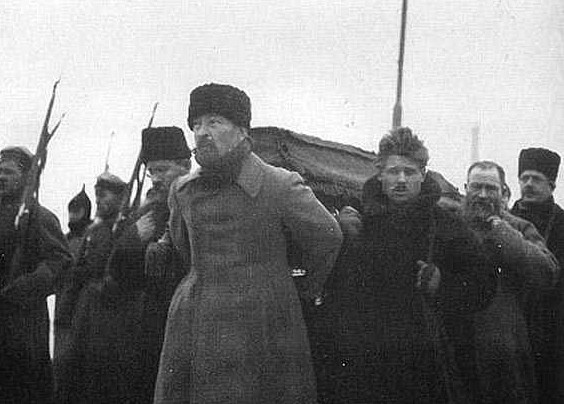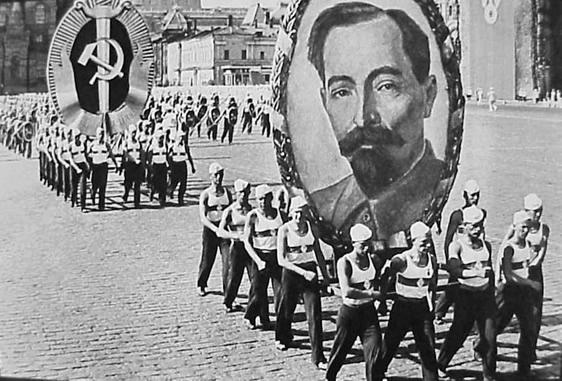<Back to Index>
- Astronomer James Hopwood Jeans, 1877
- Poet James Thomson, 1700
- Founding Director of the Cheka Felix Edmundovich Dzerzhinsky, 1877
PAGE SPONSOR
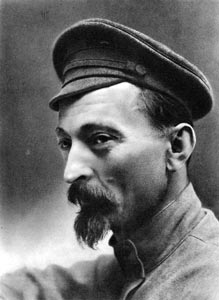
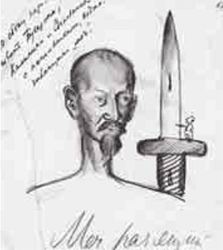
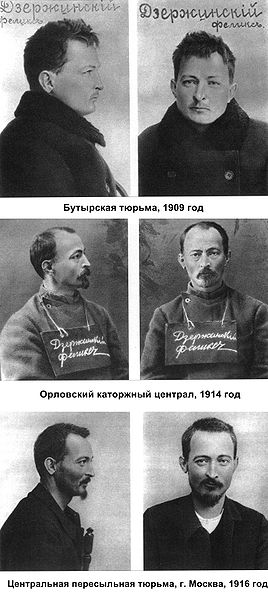
Felix Edmundovich Dzerzhinsky (Polish: Feliks Dzierżyński, Russian: Феликс Эдмундович Дзержинский; 11 September [O.S. 30 August] 1877–July 20, 1926) was a Communist revolutionary, famous as the first director of the Bolshevik secret police, the Cheka, known later by many names during the history of the Soviet Union. The agency became notorious for torture and mass summary executions, performed especially during the Red Terror and the Russian Civil War.
Felix Dzerzhinsky was born into a purported Polish szlachta (noble) family of the Samson coat of arms. His father was a Polish Jew named Szeloahim Rufin (who bought the property of a Polish nobleman Dzierżyński from the Russian Tsar after it was confiscated by the Russian authorities). Young Dzerzhinsky grew up at the Dziarzhynava estate near Ivyanets and Rakaw in Western Belarus (in present day Minsk Voblast), then part of the Russian Empire. As a youngster Dzerzhinsky was fluent in three languages Polish, Russian and Yiddish. He attended the Russian gymnasium at Vilnius 1887 - 95. One of the older students at this gymnasium was his future archenemy, Józef Piłsudski. Years later, as Marshal of the interwar Polish state, Piłsudski generously recalled that Dzerzhinsky "distinguished himself as a student with delicacy and modesty. He was rather tall, thin and demure, making the impression of an ascetic with the face of an icon. ... Tormented or not, this is an issue history will clarify; in any case this person did not know how to lie."
Two months before graduating, Dzerzhinsky was expelled from the gymnasium for "revolutionary activity". He had joined a Marxist group — the Union of Workers (SDKP) during 1895. In late April 1896 he was one of 15 delegates at the first congress of the Lithuanian Social Democratic Party (LSDP). He was subsequently one of the founders of Social Democracy of the Kingdom of Poland and Lithuania (SDKPiL) during 1899. He spent a large part of his early life in various prisons. During 1897 he attended the second congress of the LSDP where it rejected independence in favour of national autonomy. On March 18, 1897 he was sent to Kovno, to take advantage of the arrest of the Polish Socialist Party (PPS) branch. He worked in a book binding factory and set up an illegal press. As an organizer of a shoemaker's strike, Dzerzhinsky was arrested for "criminal agitation among the Kovno workers" and the police files from this time state that: "Felix Dzerzhinsky, considering his views, convictions and personal character, will be very dangerous in the future, capable of any crime."
He was arrested for his revolutionary activities during 1897 and 1900, sent to Siberia, but escaped both times. He then travelled to Berlin and met with Rosa Luxemburg and Leo Jogiches, two prominent leaders of the Polish Social Democratic movement. They gained control of the party organization through the creation of a committee called the Komitet Zagraniczny - KZ, which dealt with the party's foreign relations. As secretary of the KZ, Dzerzhinsky was able to dominate the SDKPiL.
Dzerzhinsky went to Switzerland where his fiancee Julia Goldman was undergoing treatment for tuberculosis. She died in his arms on June 4, 1904. Her illness and death depressed him, and in letters to his sister, Dzerzhinsky explained that he no longer saw any meaning for his life. That changed with the Russian Revolution of 1905 as Dzerzhinsky was involved with work again. After the revolution failed, he was again jailed, this time by the Okhrana. He later escaped after which he spent much time abroad, while together with Jogiches reorganized the party. In many ways the SDKPiL began to be more similar philosophically to the Bolshevik faction of the Russian Social Democratic Labour Party.
Back in Kraków during 1910 Dzerzhinsky married party member Zofia Muszkat, who was already pregnant. A month later she was arrested and she gave birth to their son Janek in Pawiak prison. During 1911 Zofia Dzerzhinska was sentenced to permanent Siberian exile, and she left the child with her father. Dzerzhinsky saw his son for the first time during March 1912 in Warsaw. In attending the welfare of his child, Dzerzhinsky repeatedly exposed himself to the danger of arrest. On one occasion, Dzerzhinsky narrowly escaped an ambush that the police had prepared at the apartment of his father - in - law.
Dzerzhinsky remained to direct the Social Democratic Party, while considering his continued freedom "only a game of the Okhrana". The Okhrana, however, was not playing a game; Dzerzhinsky simply was a master of conspiratorial techniques and was therefore extremely difficult to find. A police file from this time says: "Dzerzhinsky continued to lead [the Social Democratic party] and at the same time he directed party work here [in Warsaw], he led strikes, he published appeals to workers ... and he traveled on party matters to Łódź and Kraków". The police however were unable to arrest Dzerzhinsky until the end of 1912, when they found the apartment where he lived, by the name of Władysław Ptasiński.
Dzerzhinsky would spend the next four and one-half years in tsarist prisons, first at the notorious Tenth Pavilion of the Warsaw Citadel. When World War I began during 1914, all political prisoners were relocated from Warsaw into Russia proper. Dzerzhinsky was taken initially to Oryol. He was very concerned about the fate of his wife and son, with whom he did not have any communication. Moreover, Dzerzhinsky was beaten frequently by the Russian prison guards, which caused the permanent disfigurement of his jaw and mouth. During 1916 Dzerzhinsky was relocated to the Moscow Butyrka prison, where he was soon hospitalized because the chains that he was forced to wear had caused severe cramps in his legs. Despite the prospects of amputation, Dzerzhinsky recovered and was put to labor sewing military uniforms.
Felix Dzerzhinsky was freed from Butyrki after the February Revolution of 1917.
Soon after his release, Dzerzhinsky's goal was to organize Polish
refugees in Russia and then go back to Poland and fight for the
revolution there, writing to his wife: "together with these masses we
will return to Poland after the war and become one whole with the SDKPiL". However, he remained in Moscow where he joined the Bolshevik party,
writing to his comrades that "the Bolshevik party organization is the
only Social Democratic organization of the proletariat, and if we were
to stay outside of it, then we would find ourselves outside of the
proletarian revolutionary struggle". Already
during April he entered the Moscow Committee of the Bolsheviks and soon
thereafter was elected to the Executive Committee of the Moscow Soviet.
Dzerzhinsky endorsed Vladimir Lenin's April Theses - demanding uncompromising opposition to the Russian Provisional Government, the transfer of all political authority to the Soviets, and the immediate withdrawal of Russia from the war. Dzerzhinsky
was elected subsequently to the Bolshevik Central Committee at the
Sixth Party Congress during late July. He then relocated from Moscow to Petrograd to
begin his new responsibilities. In Petrograd, Dzerzhinsky participated
in the crucial session of the Central Committee during October and he
strongly endorsed Lenin's demands for the immediate preparation of a
rebellion, after which Felix Dzerzhinsky had an active role with the Military Revolutionary Committee during the October Revolution. With the acquisition of power by the Bolsheviks, Dzerzhinsky eagerly
assumed responsibility for making security arrangements at the Smolny Institute where the Bolsheviks had their headquarters.
Vladimir
Lenin regarded Felix Dzerzhinsky as a revolutionary hero and appointed
him to organize a force to combat internal threats. On December 20,
1917, the
Council of People's Commissars officially
established the All-Russia Extraordinary Commission to Combat Counter -
revolution and Sabotage - usually known as the Cheka (based
on the Russian acronym ВЧК). Dzerzhinsky became its director. The Cheka
received a large amount of resources, and became known for ruthlessly
pursuing any perceived counter revolutionary elements. As the Russian Civil War expanded, Dzerzhinsky also began organizing internal security troops to enforce the Cheka's authority. The Cheka undertook drastic measures during the Russian Civil War. Tens of thousands of political opponents were shot without trial in the basements of prisons and in public places. In
addition, anybody with the potential or influence to oppose the
government was shot, including intellectuals, capitalists and priests. Dzerzhinsky said: "We represent in ourselves organized terror -- this must be said very clearly." and “[The Red Terror involves]
the terrorization, arrests and extermination of enemies of the revolution on the basis of their class affiliation or of their
pre-revolutionary roles.” During 1922, at the end of the Civil War, the Cheka was renamed as the GPU (State Political Directorate), a section of the NKVD.
This did not diminish Dzerzhinsky's power; he was Minister of the
Interior, director of the Cheka / GPU / OGPU, Minister for Communications, and director of the Vesenkha (Supreme Council of National Economy) from 1921 – 24 . At his office in Lubyanka, Dzerzhinsky kept a portrait of Rosa Luxemburg on the wall.
Dzerzhinsky
became a Bolshevik as late as 1917. Therefore it is wrong to claim, as
the official Soviet historians later did, that Dzerzhinsky had been one
of Lenin's oldest and most reliable comrades, or that Lenin had
exercised some sort of spellbinding influence on Dzerzhinsky and the
SDKPiL.
Lenin and Dzerzhinsky frequently had opposing opinions about many
important ideological and political issues of the pre-revolutionary
period, and also after the October Revolution. After 1917, Dzerzhinsky
would oppose Lenin on such crucial issues as the Brest - Litovsk peace,
the trade unions, and Soviet nationality policy. He had creative organizational ability and was willing to perform unwelcome and
difficult tasks. From
1917 to his death in 1926, Dzerzhinsky was first and foremost a Russian
Communist, and Dzerzhinsky's involvement in the affairs of the Polish Communist Party (which
was founded during 1918) was minimal. The energy and dedication that
had previously been responsible for the building of the SDKPiL would
henceforth be devoted to the priorities of the struggle for proletarian
power in Russia, to the defense of the revolution during the civil war,
and eventually, to the tasks of socialist construction.
Dzerzhinsky died of
heart failure on July 20, 1926 in Moscow,
immediately after a two-hour long speech to the Bolshevik Central
Committee during which, visibly quite ill, he violently denounced the United Opposition directed by Leon Trotsky, Grigory Zinoviev, and Lev Kamenev. Upon hearing of his death Joseph Stalin eulogized Dzerzhinsky as "...a devout knight of the proletariat." Nicholas Roerich and his son George were waiting in the Cheka office to see Dzerzhinsky when they heard of Dzerzhinsky's death. Dzierżyńszczyzna, one of the two Polish Autonomous Districts in the Soviet Union, was named to commemorate Dzerzhinsky. Located in Belarus, near Minsk and close to the Soviet - Polish border of the time, it was created on March 15, 1932, with the capital at (Dzyarzhynsk, Dzerzhynsk, formerly known as Kojdanów). The district was disbanded during 1935 at the onset of the Great Purge and most of its administration was executed. His name and image were used widely throughout the KGB and the Soviet Union —
and other socialist countries: there were six towns named after him.
The town Kojdanava, which is not very far from the estate, was renamed
to Dzyarzhynsk. There is also a city of Dzerzhinsk and three cities called Dzerzhinskiy in Russia and a city in Ukraine's
Donetsk Oblast named Dzerzhinsk. A Ukrainian village in the Zhytomyr
Oblast was also named Dzerzhinsk until 2005 when it was renamed
Romaniv. The Dzerzhinskiy Tractor Works in Stalingrad were named in his honor and became a scene of bitter fighting during the Second World War. There is a museum dedicated to him in his birth place in Belarus. "Iron Felix" also refers to his 15-ton iron monument, which once dominated the Lubyanka Square in Moscow, near the KGB headquarters. It was built during 1958 by sculptor Yevgeny Vuchetich and was a Moscow landmark during Soviet times. Symbolically, the Memorial to the Victims of the Gulag (a simple stone from Solovki)
was erected beside the Iron Felix and the latter was removed during
August 1991, after the failed rebellion of hard line Communist members
of government. The memorial to Dzerzhinsky was toppled by a cheering
crowd with the help of a crane. A mock-up of the removal of
Dzerzhinsky's statue can be found in the entrance hall of the International Spy Museum in Washington, D.C. During 2002, Moscow mayor Yuriy Luzhkov proposed
returning the statue to its plinth, but the plan was ended by
opposition from liberals and the national government. The statue
remained in a yard for old Soviet memorials at the Central House of
Artists, although a smaller bust of Dzerzhinsky in the courtyard of the
Moscow police headquarters at Petrovka 38 was restored during November
2005 (this bust had been removed by the police officers on 22 August
1991). His monument in "Dzerzhinsky Square" (pl. Plac Dzierżyńskiego), in the center of Warsaw, was so hated by the population of the Polish capital as a symbol of Soviet oppression that it was toppled during 1989, as soon as the PZPR started losing power. The name of the square was soon changed to its pre-Second World War name, "Bank Square" (pl: Plac Bankowy). A 10-foot bronze replica of the original Iron Felix statue was placed on the grounds of the military academy in Minsk, Belarus, during May 2006.
